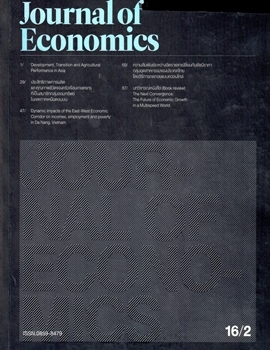ความสัมพันธ์ระหว่างอัตราแลกเปลี่ยนกับดัชนีราคากลุ่มอุตสาหกรรมของประเทศไทย โดยวิธีการถดถอยแบบควอนไทล์
Keywords:
อัตราแลกเปลี่ยน, ดัชนีราคากลุ่มอุตสาหกรรม, การถดถอยแบบควอนไทล์, การทดสอบความเป็นเหตุเป็นผล, Exchange rate, Industry Group Index, Quantile Regression, Causality TestAbstract
การศึกษานี้ทำการหาความสัมพันธ์ระหว่างอัตราแลกเปลี่ยนกับดัชนีราคากลุ่มอุตสาหกรรมทั้ง 8 กลุ่ม ของประเทศไทย โดยใช้ข้อมูลรายวัน แต่เนื่องจากข้อมูลมีลักษณะไม่นิ่ง (Nonstationary) จึงทำการปรับข้อมูลของ อัตราแลกเปลี่ยนให้อยู่ในรูปของอัตราการเปลี่ยนแปลง และปรับข้อมูลของดัชนีราคากลุ่มอุตสาหกรรมให้อยู่ในรูปของ อัตราผลตอบแทน จากนั้นทำการประมาณค่าด้วยวิธีการถดถอยแบบควอนไทล์ (Quantile Regression) ที่สามารถแสดงให้ เห็นถึงความแตกต่างของความสัมพันธ์ระหว่างตัวแปรทั้งสองตามระดับค่าต่างๆ ของตัวแปรตามได้ ผลการศึกษา กรณีที่กำหนดให้อัตราการเปลี่ยนแปลงของอั ตราแลกเปลี่ยนเป็ นตัวแปรตามนั้นพบว่าอัตราการเปลี่ยนแปลงของอัตราแลกเปลี่ยน และอัตราผลตอบแทนของดัชนีราคากลุ่มอุตสาหกรรมมีความสัมพันธ์ในทิศทางตรงกันข้าม โดยมีผลอย่างมาก ทั้ง ณ อัตราการเปลี่ยนแปลงของอัตราแลกเปลี่ยนต่ำ และสูง แต่ ณ ที่อัตราการการเปลี่ยนแปลงของอัตราแลกเปลี่ยนระดับกลาง จะมีความสัมพันธ์กันน้อยกว่า ส่วนกรณีที่อัตราผลตอบแทนของดัชนีราคากลุ่มหลักทรัพย์เป็นตัวแปรตามนั้น พบว่า อัตราการเปลี่ยนแปลงของอัตราแลกเปลี่ยนและอัตราผลตอบแทนของดัชนีราคากลุ่มหลักทรัพย์มีความสัมพันธ์ ในทิศทางตรงกันข้ามเช่นเดียวกัน แต่มีความแตกต่างกันน้อยในแต่ละระดับของอัตราผลตอบแทนของดัชนีราคากลุ่ม หลักทรัพย์ และเมื่อทำการทดสอบความเป็นเหตุเป็นผล (Causality Test) แล้วพบว่า อัตราผลตอบแทนของดัชนีราคา กลุ่มหลักทรัพย์ทุกกลุ่มมีผลต่ออัตราการเปลี่ยนแปลงของอัตราแลกเปลี่ยนในทิศทางเดียวเท่านั้น ยกเว้นกลุ่มเกษตร และอุตสาหกรรมอาหารที่พบว่าไม่มีความเป็นเหตุเป็นผลระหว่างตัวแปรทั้งสอง
This study investigated the relationship between exchange rate and 8 industry group indexes of Thailand by using daily data. To avoid nonstationary problem, the rate of change in exchange rate and rate of return in industry group index are used instead. The quantile regression technique, which can estimate the relationship between variables in any level of dependent variable, is employed. The results, in case rate of change in exchange rate is dependent variable, showed that rate of change in exchange rate and rate of return in industry group index had negative relationship. The strong relationship was found at high and low level of rate of change in exchange rate but quite strange at median level. In rate of return of industry group index is dependent variable case, rate of change in exchange rate and rate of return of industry group index also had negative relationship. However, the relationship between those two variables was not difference significantly in each level of rate of return in industry group index. The Granger causality test found uni-directional causality from rate of return of all industries group index to rate of change in exchange rate except Agro & Food Industry index that had no granger causality between two variables.
Downloads
Issue
Section
License
All opinions and contents in the CMJE are the responsibility of the author(s). Chiang Mai University Journal of Economics reserves the copyright for all published materials. Papers may not be reproduced in any form without the written permission from Chiang Mai University Journal of Economics.
ข้อคิดเห็นที่ปรากฏและแสดงในเนื้อหาบทความต่างๆในวารสารเศรษฐศาสตร์มหาวิทยาลัยเชียงใหม่ ถือเป็นความเห็นและความรับผิดชอบโดยตรงของผู้เขียนบทความนั้นๆ มิใช่เป็นความเห็นและความรับผิดชอบใดๆของวารสารเศรษฐศาสตร์ มหาวิทยาลัยเชียงใหม่
บทความ เนื้อหา และข้อมูล ฯลฯ ในวารสารเศรษฐศาสตร์มหาวิทยาลัยเชียงใหม่ ถือเป็นลิขสิทธิ์เฉพาะของคณะเศรษฐศาสตร์มหาวิทยาลัยเชียงใหม่ หากบุคคลหรือหน่วยงานใดต้องการนำทั้งหมดหรือส่วนหนึ่งส่วนใดไปเผยแพร่ต่อหรือเพื่อกระทำการใดๆ จะต้องได้รับอนุญาตเป็นลายลักษณ์อักษร จากวารสารเศรษฐศาสตร์ มหาวิทยาลัยเชียงใหม่






